2. 南京信息工程大学应用气象学院,南京 210044
太湖地区水稻栽培技术自唐代起一直处于领先地位,宋代即有“苏湖熟,天下足”的美称[1]。有关水稻穗肥精细化施用的记载始见于明末时期,《沈氏农书》载:“到了立秋,苗已长足,壅力已尽,秆必老,色必黄,接力(即穗肥)愈多愈好”[2]。在化肥进入我国之前,水稻穗肥主要是有机肥类,如浙江《南浔镇志·农桑》记载:“富家多用豆饼……贫家则用猪羊栏中腐草”[3]。新中国成立后,水稻穗肥开始普遍施用化肥,如陈永康1958年总结的单季晚粳稻“三黄三黑”高产栽培技术,提出穗肥分两次施用[4],20世纪80年代浙江创立的三高一穗栽培模式注重水稻穗肥攻粒技术[5]。如今,随着高产品种的推广,研究[6-7]表明氮肥适当后移可提高水稻产量和相关品质。
水稻穗肥施用只能采用表面撒施方式,撒施最大的问题便是氨挥发损失。近年来发现,农业氨排放与大气雾霾密切相关,稻田氮肥撒施引起的氨排放及其减排便成为关注热点[8-10]。田间研究农田氨排放的方法主要有三类,分别是无干扰的微气象学法、密闭室抽气法和被动吸收的通气法,太湖地区已有一些研究对水稻穗肥氨挥发损失进行了监测,然而大多数研究采用的是密闭室抽气法,测定的是土-水表面的氨排放[11-13]。微气象学法是国际公认的监测大面积农田氨排放的标准方法[14],该方法可测定农田生态系统冠层以上向大气的实际氨排放量,我国在稻田上开展的微气象学法多是基肥期氨排放研究[15-17]。目前缺少关于稻田穗肥施用后冠层上方氨排放的微气象学法研究,更缺乏在同一地块上同步采用不同监测方法的相关监测研究,这些现状直接影响稻田氨排放的客观评价和稻田氮肥施用的科学管理,也影响对已有氨排放结果的采用,进而影响农业氨排放清单及相关标准的制定。
本研究在太湖地区单季晚稻穗肥施用期间,同步采用微气象学法的质量平衡法(Integrated horizontal flux,IHF)、密闭室抽气法和通气法三种方法对穗肥施用后的稻田氨排放进行监测,以期对稻田氨排放的科学评估和稻田氮肥的科学管理提供依据,为农田氨排放清单的制定提供数据支撑。
1 材料与方法 1.1 试验地概况试验于2017年水稻季在中国科学院常熟农业生态实验站(31º15′15″N,120º57′43″E)开展。该实验站位于太湖地区,该地区主要种植制度为稻麦轮作,该地区海拔3.25 m,属于亚热带湿润气候,年均气温为15.5 ℃,年均降水量为1 038 mm,年均无霜期为224天。供试土壤为湖积物发育而成的潜育型水稻土(乌栅土),表层0 ~ 20 cm土壤理化特征:pH(H2O)7.36、有机质35.0 g·kg-1、全氮2.09 g·kg-1、全磷0.93 g·kg-1、阳离子交换量(CEC)20.2 cmol·kg-1。2017年水稻生长期间日平均气温与降水量见图 1。
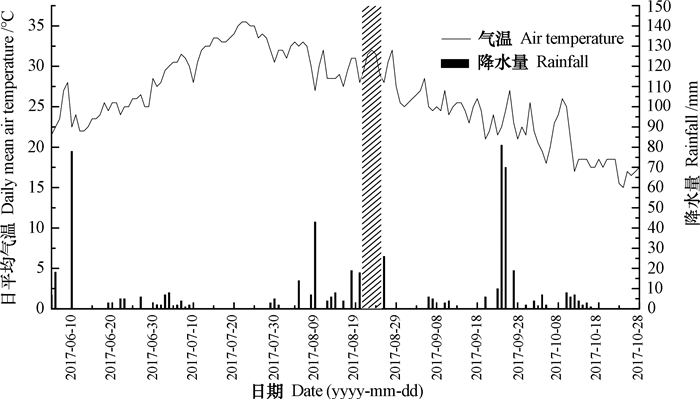
|
注:阴影部分为穗肥施用后5天气温和降雨 Note: The shaded area denotes the period of time after fertilization at the booting stage of rice 图 1 2017年水稻季日平均气温和降水分布 Fig. 1 Daily mean air temperature and distribution of rainfall during the rice season of 2017 |
在一方形稻田中间选择一个半径为20 m的圆形区域同时采用微气象学法、密闭室抽气法和通气法对稻田氨排放进行监测,圆形区域周围不施肥。微气象学法装置于圆形区域的圆心处,密闭室抽气法和通气法装置的位置见图 2,密闭室抽气法和通气法监测分别重复3次。
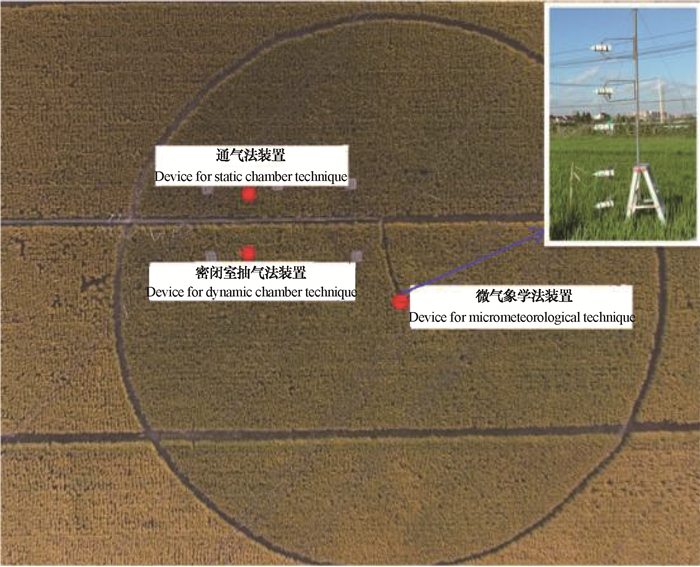
|
图 2 微气象学法、密闭室抽气法和通气法装置分布图 Fig. 2 Photograph of the location of the devices of the micrometeorological mass-balance integrated horizontal flux (IHF), the dynamic chamber technique and the static chamber technique |
水稻整个生育期圆形区域施氮量270 kg·hm-2,与该地区测土配方施肥推荐量[18]相近。氮肥(尿素)分三次施用,基肥、分蘖肥和穗肥的分配比例为4:3:3。基肥施用前10天开始泡田,2017年6月29日施基肥,基肥施用方法是表层撒施后用铁搭与表层土耙匀,随后插秧,秧龄35天。水稻品种为南粳46,插秧密度为20 cm × 20 cm。分蘖肥施用时间7月16日,穗肥施用时间8月21日,在傍晚施用。除7月29日—8月7日烤田期间以及收获前2周,其余时间均保持3~ 5 cm的表面水层。水稻于11月3日收获,其他管理与周围大田一致。
1.3 氨排放监测方法 1.3.1 微气象学法IHF基本原理是测定区域氨的垂直通量等同于测定杆上氨的垂直截面上水平迁移总量[19],在任意高度上,氨的水平通量是该高度的风速和氨浓度的乘积。Leuning等[20]发明的迎风采样器可直接测定某一高度氨的水平通量,不需单独测定风速和氨浓度。施穗肥时水稻植株高度0.70 m,氨排放监测结束时水稻植株高0.79 m,水稻冠层以上的氨排放为稻田向大气的实际排放量,因此,在圆形区域中心处的杆子上距离田面水上方的0.8 m、1.2 m、1.6 m、2.4 m和3.0 m高度处分别放置迎风采样器(图 2),同时在上风口不施肥区距离地面1.2 m处放置迎风采样器以测定背景值。
在迎风采样器使用前,将其内表面均匀涂上草酸-丙酮溶液[17]。穗肥施用后立即放置迎风采样器,第一次采集迎风采样器时间为8月23日早晨7点,之后每24 h更换一次,采回的迎风采样器立即带回实验室,用60 mL去离子水提取。
迎风采样器的水平通量uc计算公式为:
| $ \overline{u c}=M /(A \times T) $ | (1) |
式中,M为迎风采样器采样时间段内收集到的NH4+-N量,mg(以N计,下同);A为迎风采样器的有效截面积,m2;T为采样时间段,s。
氨排放通量FIHF(mg·m-2·s-1)的计算公式为[21]:
| $ F_{\mathrm{IHF}}=\frac{1}{x} \int_{0}^{z}\left[\frac{M}{A T_{\mathrm{fit}}}-\frac{M}{A T_{\mathrm{bcg}}}\right] $ | (2) |
式中,Z为高度差,m;x为风程,即圆形区域的半径,m;
密闭室抽气法需要动力[22-24],其装置由通气杆、抽气室、洗气瓶、流量计、真空泵等组成。抽气室材料为透明有机玻璃,直径20 cm,高15 cm,底部开放,顶部有2个通气孔,一个内径为25 mm的通气孔通过波纹管与2.5 m高的通气杆连通,另一个内径8 mm通气孔与盛有100 mL稀硫酸(0.01 mol·L-1)吸收液的500 mL洗气瓶相连,通过真空泵使抽气室内的气态NH3被吸收液捕获。抽气室内的换气频率为每分钟17次。根据氨排放日变化特征选择代表性时间段进行抽气测定,以此时间段的NH3挥发量作为每日的平均通量算出NH3日挥发量,直至NH3排放量与空白处无明显差异为止。
氨排放量的计算公式为:
| $ F_{\mathrm{dc}}=\frac{c \times v \times 24 \times 10^{-5}}{S \times t}-\frac{c_{0} \times v \times 24 \times 10^{-5}}{S \times t} $ | (3) |
式中,Fdc为一天内氨挥发量,kg·hm-2;c为施肥区吸收液中铵态氮浓度,mg·L-1;c0为空白区吸收液中铵态氮浓度,mg·L-1;v为吸收液体积,mL;S为密闭室覆盖的土壤面积,m2;t为一天内抽气时间段,h。
1.3.3 通气法通气法属被动收集方法。其装置为内径15 cm、高度20 cm、两端开口的聚氯乙烯(PVC)圆筒,其中一端插入土壤,在圆筒内放置两层厚度为2 cm的海绵[25-26],下层海绵距离田面水表面5 cm,防止海绵接触田面水,此层海绵用于吸收田面水表面挥发的氨;上层海绵置于圆筒顶部,用于吸收周围空气中的氨。圆筒顶部有防雨棚。两层海绵均浸有磷酸甘油溶液(50 mL磷酸+ 40 mL丙三醇,定容至1 L),磷酸甘油溶液浸入量以海绵悬挂静置后不滴液为准。氨挥发监测在穗肥施用后立即进行,每24 h更换一次下层海绵,直至与不施肥区域无明显差异为止,上层海绵每48 h更换一次。取样时,将海绵迅速装入编号的自封袋,同时换上浸过磷酸甘油的备用海绵,在实验室内向袋中加入300 mL 2 mol·L-1的KCl溶液,反复挤压提取。
土-水表面氨挥发速率:
| $ \mathrm{NH}_{3}-\mathrm{N}\left(\mathrm{kg} \cdot \mathrm{hm}^{-2} \cdot \mathrm{d}^{-1}\right)=\frac{M_{\mathrm{sc}}}{A \times D} \times 10^{-2} $ | (4) |
式中,Msc为每次取样时施肥区和空白区海绵提取液NH4+-N量之差,mg;A为PVC圆筒的截面积,m2;D为海绵收集氨时间,d。
1.4 测定方法穗肥施用后,每天上午9:00采集圆形区域和不施肥区田面水并测定田面水pH,施肥区和空白区田面水分别采集3个样品,每个样品为5处田面水混合液,带回实验室过滤后置于4℃冰箱保存,一周内测定。田面水、迎风采样器提取液、密闭室抽气法吸收液以及海绵浸提液中的NH4+-N均采用靛酚蓝比色法测定。田面水pH采用pH计测定,降雨采用智能降水采样器(ZJC型,浙江恒达仪器仪表有限公司,浙江杭州)收集。
1.5 数据分析监测数据采用Excel 2010进行处理分析,计算其平均值和标准偏差,作图软件采用Origin 8.0。
2 结果 2.1 密闭室抽气法监测氨排放日变化特征及该法抽气时间选择本研究监测了施肥后第三天土-水表面氨挥发的日变化特征,每两小时采集一次,每次采集半小时。结果发现,土-水表面氨挥发与气温呈直线相关关系(图 3);氨挥发量最大值出现在中午12:20 ~ 12:50,最小值出现在凌晨1:20 ~ 1:50,平均值出现在两个时段:8:20 ~ 8:50和16:20 ~ 16:50(图 4),因此,采用密闭室抽气法监测土-水表面氨排放的适宜时间段是8:00 ~ 9:00和16:00 ~ 17:00。
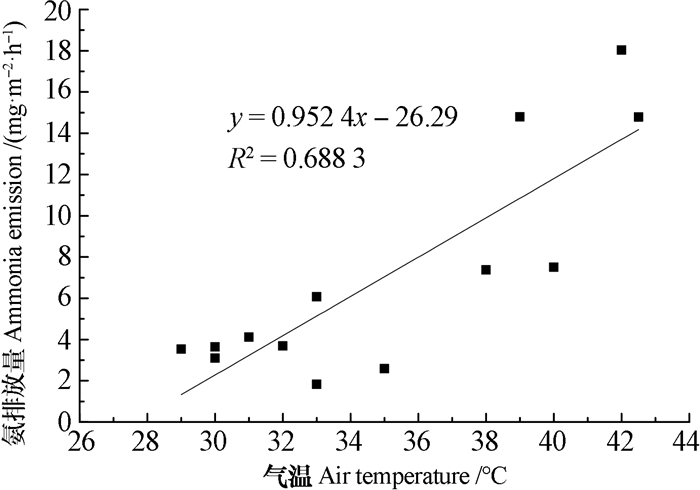
|
图 3 密闭室抽气法监测土-水表面氨排放与气温的相关关系 Fig. 3 Linear correlation between air temperature and ammonia emission from soil-water surface monitored with the dynamic chamber technique |
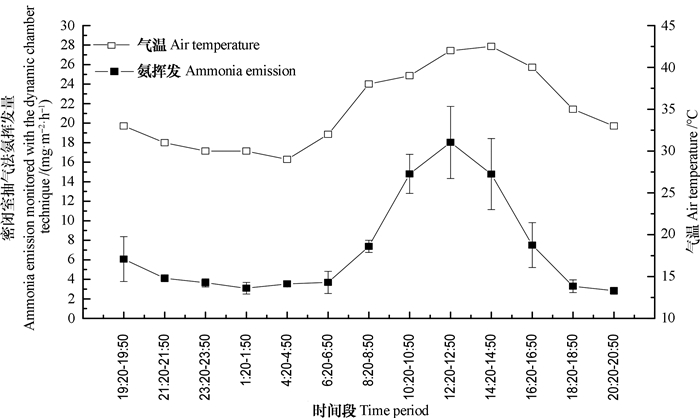
|
图 4 密闭室抽气法监测土-水表面氨排放日变化特征 Fig. 4 Diurnal variation of ammonia emission from water-soil surface monitored with the dynamic chamber technique |
在穗肥施用前,施肥区(已施过基肥和分蘖肥)和非施肥区田面水NH4+-N浓度为0.15 mg·L-1。通过对试验地水稻季灌溉水和雨水进行观测,发现灌溉河水NH4+-N浓度平均0.5 mg·L-1,雨水NH4+-N浓度为1.1 ~ 1.5 mg·L-1。在水稻非施肥期,稻田田面水NH4+-N浓度明显低于供水的NH4+-N浓度,该时期稻田对灌溉水和雨水具有净化效应。在穗肥施用后,施肥区田面水在施肥后第二天NH4+-N浓度即达到峰值,至第五天已接近非施肥区(图 5),非施肥区田面水NH4+-N浓度始终保持在0.15 ~ 0.20 mg·L-1。

|
图 5 穗肥施用后田面水NH4+-N浓度和pH动态变化 Fig. 5 Dynamics of the ammonium concentration and pH in floodwater after application of the booting fertilizer |
在穗肥施用后,施肥区仅在第2 ~ 3天pH升高了0.2左右,其他时间与非施肥区无差异。此时施肥区水稻高度已由插秧时的0.32 m生长至穗肥施用前的0.68 m,穗肥氨排放监测结束时,水稻高度为0.79 m,田面已经封行,田面水光线缺乏,导致藻类活动受阻,应是pH未出现明显升高的原因。
2.3 三种方法监测的氨排放动态变化采用三种方法监测的穗肥氨排放动态变化特征基本一致(图 6):在施肥后第二天达峰值,至施肥后第5天不再有明显排放,这些动态变化规律与田面水NH4+-N浓度变化趋势一致。然而,不同监测方法之间监测的氨排放的日排放量差异明显,密闭室抽气法和通气法监测的是土-水表面的氨排放,在监测期间,前者的日挥发量始终高于后者,如密闭室抽气法的峰值为6.85 kg·hm-2·d-1,通气法峰值为3.06 kg·hm-2·d-1,微气象学法IHF监测的冠层上方氨排放量在施肥后0~36 h的氨排放仅为3.02 kg·hm-2。
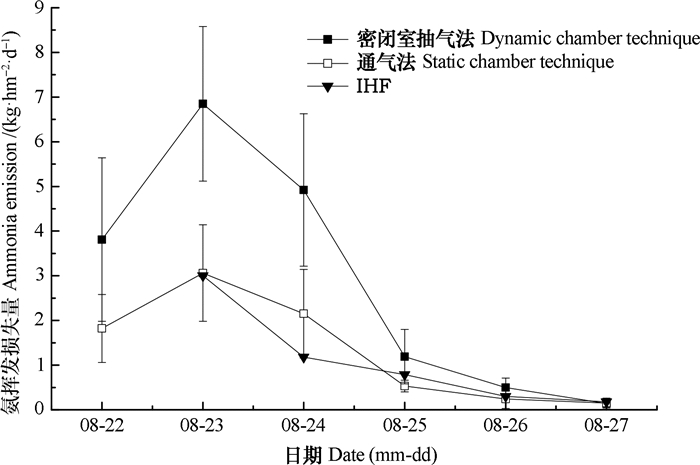
|
图 6 穗肥施用后同步采用微气象学法、密闭室抽气法和通气法监测的氨排放动态变化 Fig. 6 Dynamics of ammonia emission relative to monitoring techniques |
穗肥施用后,微气象学法IHF、密闭室抽气法和通气法监测的氨排放累积量分别为5.45 kg·hm-2、17.41 kg·hm-2和7.95 kg·hm-2,分别占施氮量的6.73%、21.5%和9.82%(表 1)。如以微气象学法IHF监测的氨排放为基数100,密闭室抽气法与通气法则分别为319和146,因此,采用密闭室抽气法或通气法均会高估穗肥施用后稻田氨排放量。
|
|
表 1 同步采用微气象学法、密闭室抽气法和通气法监测的穗肥施用后氨排放量及其占施氮量的比例 Table 1 Ammonia emission and loss rate following fertilization at the booting stage of rice plant relative to monitoring techniques |
我国农田氨挥发研究绝大多数采用密闭室抽气法[27],在太湖地区常规施氮量(240~300 kg·hm-2)下穗肥期氨挥发损失率为4%~26%[11-13, 28-31];通气法氨挥发损失率为7%~9%[32-33]。本研究采用密闭室抽气法监测土-水表面氨排放占施氮量的21.5%,通气法监测土-水表面氨排放损失率为9.82%。本研究密闭室抽气法的结果高于大部分已发表的结果,施肥后氨排放量及比例与气象条件有关,本研究的穗肥施用后五天均是高温天气(图 1),有利于氨挥发的产生。然而,造成密闭室抽气法监测结果差异大的更重要的因素应是抽气速率的不一致和抽气时间的选择两个方面,目前在田间实地监测时,尚难以做到全部试验小区均在流量计的控制下确保换气速率完全一致并足量,即要求所有抽气室内田面水至抽气室顶部的高度和抽气量完全一致。
现有研究中密闭室抽气法的抽气室大多采用直径20 cm、高度15 cm的有机玻璃气室,监测时抽气室内田面水至气室顶部的高度一般不小于3~ 4 cm,否则抽气室内的田面水有进入洗气瓶的风险,也会导致每次抽气前按压抽气室进入稻田土层的难度加大。在换气次数为每分钟15~20次的条件下,抽气量即为15~25 L·min-1。在田间情况下采用真空泵负压抽取氨排放时,洗气瓶的曝气程度直接受抽气量影响,采用的洗气瓶一般为250 mL,吸收液为60 mL,在抽气速率为15 L·min-1和20 L·min-1时洗气瓶内稀硫酸曝气程度非常剧烈,在水稻季高温条件下采用这样的抽气量会导致吸收液损耗过大,引起测定误差;另一个影响因素是抽气时间的选择,现有密闭室抽气法研究的时间选择尚不一致。因此,抽气速率和抽气时间均增加了此方法监测氨排放量的不确定性,今后的研究中,在确保施肥均匀和抽气位置和抽气时间段具有代表性的前提下,可适当减小抽气室直径,并统一控制抽气室内田面水至气室顶部的高度和抽气流量,使不同处理之间具有可比性。
3.2 三种监测方法稻田穗肥期氨排放的差异本研究中微气象学法IHF监测的水稻冠层上方氨排放仅为密闭室抽气法监测的土-水表面氨排放量的31.3%,主要原因是二者监测对象不同,前者监测的是冠层上方的氨排放,后者监测的是土-水表面的氨排放。植物冠层是开放体系,与环境中气态NH3存在吸收
该地区已开展的关于水稻穗肥施用后氨排放的微气象学法研究,其采样器高度最低处为0.4 m [37],这部分冠层内部的NH3通量会被采样器上方的冠层重新截获,这部分氨通量若算入则会高估稻田生态系统向大气的氨排放量。因此,对于稻田穗肥施用后氨排放的评价,现有的土-水表面的氨排放监测结果尚不能等同于稻田生态系统向大气的排放量,若仅是为了评价各种减排措施对土壤氨排放的减排效果时,该方法可行。
我国单季稻穗肥施用历史悠久,鉴于目前对于追肥撒施引起的氨挥发损失的关注,本研究结果表明,对于单季稻穗肥施用后,尽管是在高温天气条件下,采用普通尿素表面撒施的方式,其冠层上方的氨排放量损失率为6.73%,明显低于密闭室抽气法的监测结果,这对于合理评价稻田氮肥施用以及稻田氨排放提供了一个研究依据。
3.3 三种监测方法的优缺点在评价农田生态系统实际氨排放时,应采用微气象学法,该方法不需要外源动力,然而,该法需要试验面积大,圆形试验区半径至少20 m[38],试验区周围不能有明显氨排放源和高大建筑物;在试验区中心处至少放置5个高度的迎风采样器,最上方高度一般不低于3 m,迎风采样器的安装须对风向变动敏感,试验开始前须反复调试其支撑点位置,使其对风向的变动反应灵敏,不同高度的迎风采样器方向保持一致,因此,由于其对试验区和采样设备的要求较高,微气象学法难以应用于多处理的对比试验。密闭室抽气法监测的是土表或土-水表面氨排放,需要试验面积较小,适用于多处理的对比试验,该方法装置比较复杂,包括真空泵、流量计、密闭室、洗气瓶和进气管等,监测工作量较大,同时需要动力设备,因此,在供电不方便的野外不适用。通气法所需设备最为简单,不需要外源动力,操作简便,在无动力设备的条件下,该法可用于比较不同处理的氨排放情况。
4 结论太湖地区单季稻穗肥施用历史悠久,本研究在水稻孕穗期追施普通尿素,采用微气象学法IHF在不干扰自然环境情况下监测冠层上方氨排放,发现穗肥期稻田生态系统氨排放占施氮量的6.73%;密闭室抽气法和通气法改变了氨排放的自然环境,未能考虑水稻冠层对土-水表面挥发氨的截获,高估了穗肥期稻田氨排放。目前采用密闭室抽气法监测氨排放的研究存在的主要问题是抽气速率不一致以及抽气时间选择两方面,本研究经过监测氨排放的日变化特征,确定最佳抽气时间段是8:00 ~ 9:00和16:00 ~ 17:00,建议应用该方法时应统一抽气时间、抽气室规格和抽气量。
| [1] |
高斯得. 耻堂存稿. 北京: 中华书局, 1985. Gao S D. The preserved manuscript of the Chi Tang(In Chinese) (In Chinese). Beijing: Zhonghua Book Company, 1985. (  0) 0) |
| [2] |
张履祥辑补, 陈恒力校点.沈氏农书.北京: 中华书局, 1956 Zhang L X, Chen H L. Shen's book on agriculture(In Chinese). Beijing: Zhonghua Book Company, 1956 (  0) 0) |
| [3] |
汪曰桢.南浔镇志·农桑.浙江南浔, 1858 Wang Y Z. Nanxun chronicle-Agriculture(In Chinese). Nanxun, Zhejiang, 1858 (  0) 0) |
| [4] |
中共松江县委员会. 陈永康水稻栽培经验. 上海: 上海科学技术出版社, 1961. Songjiang County Committee. Rice cultivation experience of Chen Yongkang(In Chinese) (In Chinese). Shanghai: Shanghai Science & Technology Press, 1961. (  0) 0) |
| [5] |
程世华. 建国以来钱江太湖区稻作栽培技术的发展. 古今农业, 1993(4): 48-54. Cheng S H. Development of rice cultivation techniques in Qianjiang-Taihu area since the founding of the People's Republic of China (In Chinese). Ancient and Modern Agriculture, 1993(4): 48-54. (  0) 0) |
| [6] |
Sui B, Feng X M, Tian G L, et al. Optimizing nitrogen supply increases rice yield and nitrogen use efficiency by regulating yield formation factors . Field Crops Research, 2013, 150: 99-107. DOI:10.1016/j.fcr.2013.06.012
(  0) 0) |
| [7] |
艾玉春, 董月, 汪吉东, 等. 水稻产量主要养分限制因子及养分运筹应对技术研究. 江苏农业学报, 2015, 31(3): 558-563. Ai Y C, Dong Y, Wang J D, et al. The nutrient limiting rice production and its input models (In Chinese). Jiangsu Journal of Agricultural Sciences, 2015, 31(3): 558-563. DOI:10.3969/j.issn.1000-4440.2015.03.015 (  0) 0) |
| [8] |
巨晓棠, 谷保静, 蔡祖聪. 关于减少农业氨排放以缓解灰霾危害的建议. 科技导报, 2017, 35(13): 11-12. Ju X T, Gu B J, Cai Z C. Suggestions on reducing agricultural ammonia emissions to alleviate haze hazards (In Chinese). Science & Technology Review, 2017, 35(13): 11-12. (  0) 0) |
| [9] |
Bessagnet B, Beauchamp M, Guerreiro C, et al. Can further mitigation of ammonia emissions reduce exceedances of particulate matter air quality standards? . Environmental Science & Policy, 2014, 44: 149-163.
(  0) 0) |
| [10] |
Aneja V P, Schlesinger W H, Erisman J W. Effects of agriculture upon the air quality and climate:research, policy, and regulations . Environmental Science and Technology, 2009, 43: 4234-4240. DOI:10.1021/es8024403
(  0) 0) |
| [11] |
黄进宝, 范晓晖, 张绍林. 太湖地区铁渗水耕人为土稻季上氮肥的氨挥发. 土壤学报, 2006, 43(5): 786-792. Huang J B, Fan X H, Zhang S L. Ammonia volatilization from nitrogen fertilizer in the rice field of Fe-leachi-stagnic anthrosols in the Taihu Lake region (In Chinese). Acta Pedologica Sinica, 2006, 43(5): 786-792. DOI:10.3321/j.issn:0564-3929.2006.05.012 (  0) 0) |
| [12] |
周伟, 田玉华, 尹斌. 太湖地区水稻追肥的氨挥发损失和氮素平衡. 中国生态农业学报, 2011, 19(1): 32-36. Zhou W, Tian Y H, Yin B. Ammonia volatilization and nitrogen balance after topdressing fertilization in paddy fields of Taihu Lake region (In Chinese). Chinese Journal of Eco-Agriculture, 2011, 19(1): 32-36. (  0) 0) |
| [13] |
田玉华, 贺发云, 尹斌, 等. 太湖地区氮磷肥施用对稻田氨挥发的影响. 土壤学报, 2007, 44(5): 893-900. Tian Y H, He F Y, Yin B, et al. Ammonia volatilization from paddy fields in the Taihu Lake region as affected by N and P combination in fertilization (In Chinese). Acta Pedologica Sinica, 2007, 44(5): 893-900. DOI:10.3321/j.issn:0564-3929.2007.05.018 (  0) 0) |
| [14] |
Sommer S G, Misselbrook T H. A review of ammonia emission measured using wind tunnels compared with micrometeorological techniques . Soil Use and Management, 2016, 32: 101-108. DOI:10.1111/sum.2016.32.issue-S1
(  0) 0) |
| [15] |
Cai G X, Zhu Z L, Trevitt A, et al. Nitrogen loss from ammonium bicarbonate and urea fertilizers applied to flooded rice . Fertilizer Research, 1986, 10(1): 203-215.
(  0) 0) |
| [16] |
Zhu Z L, Cai G X, Simpson J, et al. Processes of nitrogen loss from fertilizers applied to flooded rice fields on a calcareous soil in north-central China . Fertilizer Research, 1988, 18(2): 101-115.
(  0) 0) |
| [17] |
Cai G X, Peng G H, Wang X, et al. Ammonia volatilization from urea applied to acid paddy soil in southern China and its control . Pedosphere, 1992(4): 345-354.
(  0) 0) |
| [18] |
吴良泉, 武良, 崔振岭, 等. 中国水稻区域氮磷钾肥推荐用量及肥料配方研究. 中国农业大学学报, 2016, 21(9): 1-13. Wu L Q, Wu L, Cui Z L, et al. Studies on recommended nitrogen, phosphorus and potassium application rates and special fertilizer formulae for different rice production regions in China (In Chinese). Journal of China Agricultural University, 2016, 21(9): 1-13. (  0) 0) |
| [19] |
Denmead O T, Simpson J R, Freney J R. A direct field measurement of ammonia emission after injection of anhydrous ammonia . Soil Science Society of America Journal, 1977, 41: 1001-1004. DOI:10.2136/sssaj1977.03615995004100050039x
(  0) 0) |
| [20] |
Leuning R, Freney J R, Denmead O T, et al. A sampler for measuring atmospheric ammonia flux . Atmospheric Environment, 1985, 19(7): 1117-1124. DOI:10.1016/0004-6981(85)90196-9
(  0) 0) |
| [21] |
Engel R, Jones C, Romero C, et al. Late-fall, winter and spring broadcast applications of urea to no-till winter wheat I. Ammonia loss and mitigation by NBPT . Soil Science Society of America Journal, 2017, 81: 322-330. DOI:10.2136/sssaj2016.10.0332
(  0) 0) |
| [22] |
朱兆良, 蔡贵信, 徐银华, 等. 种稻下氮肥的氨挥发及其在氮素损失中的重要性的研究. 土壤学报, 1985, 22(4): 320-328. Zhu Z L, Cai G X, Xu Y H, et al. Ammonia volatilization and its significance to the losses of fertilizer nitrogen applied to paddy soil (In Chinese). Acta Pedologica Sinica, 1985, 22(4): 320-328. (  0) 0) |
| [23] |
Kissel D E, Brewer H L, Arkin G F. Design and test of a field sampler for ammonia volatilization . Soil Science Society of America Journal, 1977, 41(6): 1133-1138. DOI:10.2136/sssaj1977.03615995004100060024x
(  0) 0) |
| [24] |
周伟, 田玉华, 曹彦圣, 等. 两种氨挥发测定方法比较研究. 土壤学报, 2011, 48(5): 1090-1095. Zhou W, Tian Y H, Cao Y S, et al. A comparative study on two methods for determine of ammonia volatilization (In Chinese). Acta Pedologica Sinica, 2011, 48(5): 1090-1095. (  0) 0) |
| [25] |
王朝辉, 刘学军, 巨晓棠. 田间土壤氨挥发的原位测定-通气法. 植物营养与肥料学报, 2002, 8(2): 205-209. Wang Z H, Liu X J, Ju X T. Field in situ determination of ammonia volatilization from soil:Venting method (In Chinese). Plant Nutrition and Fertilizer Science, 2002, 8(2): 205-209. DOI:10.3321/j.issn:1008-505X.2002.02.014 (  0) 0) |
| [26] |
Bosch-Serra à D, Yagüe M R, Teira-Esmatges M R. Ammonia emissions from different fertilizing strategies in Mediterranean rainfed winter cereals . Atmospheric Environment, 2014, 84: 204-212. DOI:10.1016/j.atmosenv.2013.11.044
(  0) 0) |
| [27] |
Zhou F, Ciais P, Hayashi K, et al. Re-estimating NH3 emissions from Chinese cropland by a new nonlinear model . Environmental Science & Technology, 2016, 50: 564-572.
(  0) 0) |
| [28] |
Wang J, Wang D J, Zhang G, et al. Effect of wheat straw application on ammonia volatilization from urea applied to a paddy?eld . Nutrient Cycling Agroecosystems, 2012, 94(1): 73-84. DOI:10.1007/s10705-012-9527-8
(  0) 0) |
| [29] |
Lin Z C, Dai Q G. Effects of nitrogen application levels on ammonia volatilization and nitrogen utilization during rice growing season . Rice Science, 2012, 19: 125-134. DOI:10.1016/S1672-6308(12)60031-6
(  0) 0) |
| [30] |
张静, 王德建. 太湖地区乌栅土稻田氨挥发损失的研究. 中国生态农业学报, 2007, 15(6): 84-87. Zhang J, Wang D J. Ammonia volatilization in gleyed paddy field soils of Taihu Lake region (In Chinese). Chinese Journal of Eco-Agriculture, 2007, 15(6): 84-87. (  0) 0) |
| [31] |
孙海军, 闵炬, 施卫明, 等. 硝化抑制剂施用对水稻产量与氨挥发的影响. 土壤, 2015, 47(6): 1027-1033. Sun H J, Min J, Shi W M, et al. Effects of nitrification inhibitor on rice production and ammonia volatilization in paddy rice field (In Chinese). Soils, 2015, 47(6): 1027-1033. (  0) 0) |
| [32] |
俞巧钢, 叶静, 杨梢娜, 等. 不同施氮量对单季稻养分吸收及氨挥发损失的影响. 中国水稻科学, 2012, 26(4): 487-494. Yu Q G, Ye J, Yang S N, et al. Effects of different nitrogen application levels on rice nutrient uptake and ammonia volatilization (In Chinese). Chinese Journal of Rice Science, 2012, 26(4): 487-494. DOI:10.3969/j.issn.1001-7216.2012.04.015 (  0) 0) |
| [33] |
He Y P, Yang S H, Xu J Z, et al. Ammonia volatilization losses from paddy fields under controlled irrigation with different drainage treatments. The Scientific World Journal, 2014 Article ID: 417605
(  0) 0) |
| [34] |
Farquhar G D, Firth P M, Wetselaar R, et al. On the gaseous exchange of ammonia between leaves and the environment:determination of the ammonia compensation point . Plant Physiology, 1980, 66(4): 710-714. DOI:10.1104/pp.66.4.710
(  0) 0) |
| [35] |
Sutton M A, Erisman J W, Dentener F, et al. Ammonia in the environment:from ancient times to the present . Environmental Pollution, 2008, 156: 583-604. DOI:10.1016/j.envpol.2008.03.013
(  0) 0) |
| [36] |
Hayashi K, Hiradate S, Ishikawa S, et al. Ammonia exchange between rice leaf blades and the atmosphere:Effect of broadcast urea and changes in xylem sap and leaf apoplastic ammonium concentrations . Soil Science and Plant Nutrition, 2008, 54: 807-818. DOI:10.1111/j.1747-0765.2008.00299.x
(  0) 0) |
| [37] |
宋勇生, 范晓晖, 林德喜, 等. 太湖地区稻田氨挥发及影响因素的研究. 土壤学报, 2004, 41(2): 265-269. Song Y S, Fan X H, Lin D X, et al. Ammonia volatilization from paddy fields in the Taihu Lake region and its influencing factors (In Chinese). Acta Pedologica Sinica, 2004, 41(2): 265-269. DOI:10.3321/j.issn:0564-3929.2004.02.016 (  0) 0) |
| [38] |
Wilson J D, Catchpool V R, Denmead O T, et al. Verification of a simple micrometeorological method for estimating the rate of gaseous mass transfer from the ground to the atmosphere . Agricultural Meteorology, 1983, 57: 281-295.
(  0) 0) |
2. School of Applied Meteorology, Nanjing University of Information Science & Technology, Nanjing 210044, China
 2019, Vol. 56
2019, Vol. 56

